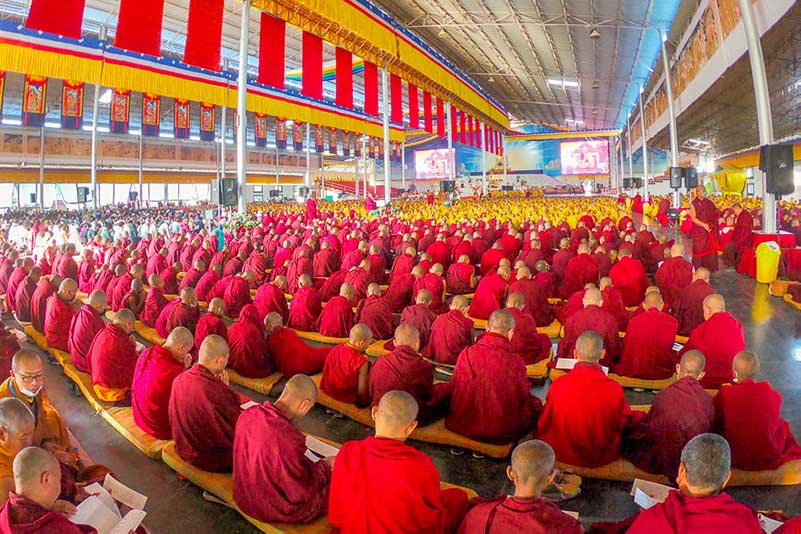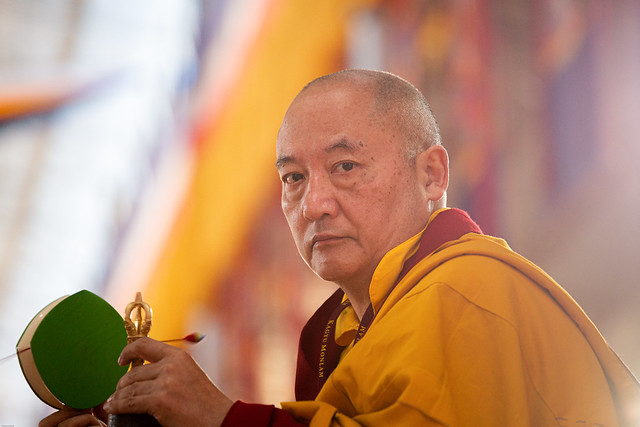
The Pavilion, Bodh Gaya, India
January 31, 2020
On the day following the Pre-Monlam Teachings and before the Monlam proper, the vajra assembly of Rinpoches, tulkus, monks, nuns, and faithful lay followers gathered in the Monlam pavilion to accumulate 1 million feast offerings dedicated to His Holiness the Karmapa’s good health and long life. The vehicle for this activity, selected by the Monlam steering committee and translated into English and Chinese specifically for the occasion, was the practice of Sangtik Dorsem, The Single Mudra Vajrasattva, an earth-treasure revealed by the great 19th-century terton Chokyur Dechen Lingpa and part of his Sangtik Nyingpo (Essential Secret Essence) cycle.
This practice has deep roots in the Karma Kagyu lineage, as Chokyur Lingpa recovered it at Tsadra Rinchen Drak, the hermitage of Jamgon Kongtrul Lodro Thaye perched high above Palpung Sherabling monastery in Kham, eastern Tibet. The practice was then committed to writing by the Eleventh Tai Situpa, Situ Pema Wangchuk, and the Fifteenth Gyalwang Karmapa wrote the opening supplication.
A simple and elegant shrine graced the stage to the left of the seated rinpoches. On its top tier, a majestic, tall deity torma, topped by a regal, snow-white umbrella, represented the deity. The shrine’s middle level held the traditional inner offerings — Dutsi (nectar) and rakta in ornate skullcups, with a tray of torma (butter sculpture food offerings) set in between. During the practice, these substances would be repeatedly offered, again and again, with several attendants working to refresh the torma trays after each repetition of the feast liturgy. On the lowest level of the shrine, in gorgeous offering bowls, the eight outer offerings were set out: drinking water, water for washing, flowers, incense, a butter lamp, perfume, food, and music. On the marble stairs flanking both sides of the spacious stage, colorful bags of tsok (feast offerings) peeped out of a dazzling array of bags and boxes —enough for everyone present to take home a generous portion. Feast practices emphasize abundance, and that quality was on full display from the start.
The gyalings, traditional Tibetan horns, sounded the arrival of the Vajra Master, His Eminence Goshir Gyaltsab Rinpoche, just after 8:00 a.m. Once he and the assembly were seated, opening prayers commenced. Much of the first session was devoted to generating the visualization, inviting the deity, and presenting a dazzling array of offerings. Then, after a break for butter tea, the feast accumulations began in earnest. Except during the lunch and afternoon tea breaks, the assembled devotees chanted a short feast liturgy for most of the day.
Most essential was a beautiful six-line supplication accompanying the feast offering. A note in the text stated, “It is excellent if you can repeat these six lines, since they encompass all aims.” Again and again, practitioners chanted:
Hum! Bhagavan and retinue,
Please accept this ocean of offerings!
The ocean of violations and breaches I confess!
May the ocean of sacred bonds be fulfilled!
I beseech you, grant an ocean of siddhis!
I entreat you, perform an ocean of activities!
As everyone chanted the liturgy, the chöpon (shrine master) and a group of assistants worked diligently to repeatedly purify and then offer the feast substances to the deity torma. They appeared to keep the practice fresh with each repetition; the synchronicity of their movements had a meditative quality. Long tables covered with trays of torma allowed them to prepare seemingly endless offerings, and those already offered were smoothly cleared away to make room for the next cycle.
When the practice ended with auspicious prayers, just after 5 p.m., the assembly had collectively generated 1,155,000 repetitions of the feast.These were dedicated to His Holiness Karmapa, the lineage holders of the Karma Kagyu, and all sentient beings’ welfare and happiness. Everyone left with a bag of tsok and a sense of accomplishment. They walked out into a beautiful, sunlit late afternoon, hearts and hands full.
May all sentient beings enjoy abundance and an array of good things! May the Gyalwang Karmapa live long, and may his activity flourish!


































